Like Dorothy discovering she’d had the power to go home all along, you’ve probably got the perfect plants for your Texas landscape right in your own backyard—or at least in your state’s native flora. You’ll find that drought-resistant natives like Bluebonnets, Indian Paintbrush, and Black-Eyed Susan aren’t just survivors, they’re thrivers that’ll cut your water bill by 30-50% while supporting local wildlife. But choosing the right combination for your specific zone requires understanding something most gardeners overlook.
Contents
- 1 Texas Climate and Growing Zones
- 2 Texas Wildflower Champions
- 3 Heat-Tolerant Native Texas Trees
- 4 Drought-Tolerant Native Texas Shrubs
- 5 Selecting the Right Native Plants for Your Garden
- 6 Frequently Asked Questions
- 6.1 How Often Should I Water Newly Planted Native Texas Plants?
- 6.2 What Native Texas Plants Attract Butterflies and Hummingbirds?
- 6.3 Can Drought-Resistant Native Plants Survive Texas Freeze Events?
- 6.4 Where Can I Purchase Native Texas Plant Seeds Locally?
- 6.5 Do Native Texas Plants Require Special Fertilizers or Soil Amendments?
Texas Climate and Growing Zones
Understanding Texas’s diverse climate zones sets the foundation for successful drought-resistant gardening across this vast state. You’ll find USDA zones ranging from 6a in northern regions to 9b along the coast, with minimum temperatures spanning -10°F to 30°F. The Panhandle experiences zone 7a conditions, while Houston enjoys milder 9a winters.
Your location determines planting windows: zone 6 gardeners plant March through May, but zone 9 residents can start January first. These climate adaptation strategies help you choose plants wisely. Regional plant diversity thrives when you match species to your specific zone, considering both temperature extremes and seasonal timing for peak success. This wide range of zones enables cold-hardy plants to flourish in northern Texas while supporting heat-loving varieties further south.
Texas Wildflower Champions
Texas boasts remarkable wildflowers that thrive in drought conditions, including iconic state blooms, exceptional pollinator supporters, long-blooming survivors, and species perfectly adapted to local landscapes. These native species require lower maintenance compared to non-native alternatives while supporting the state’s unique environmental challenges.
Indian Paintbrush
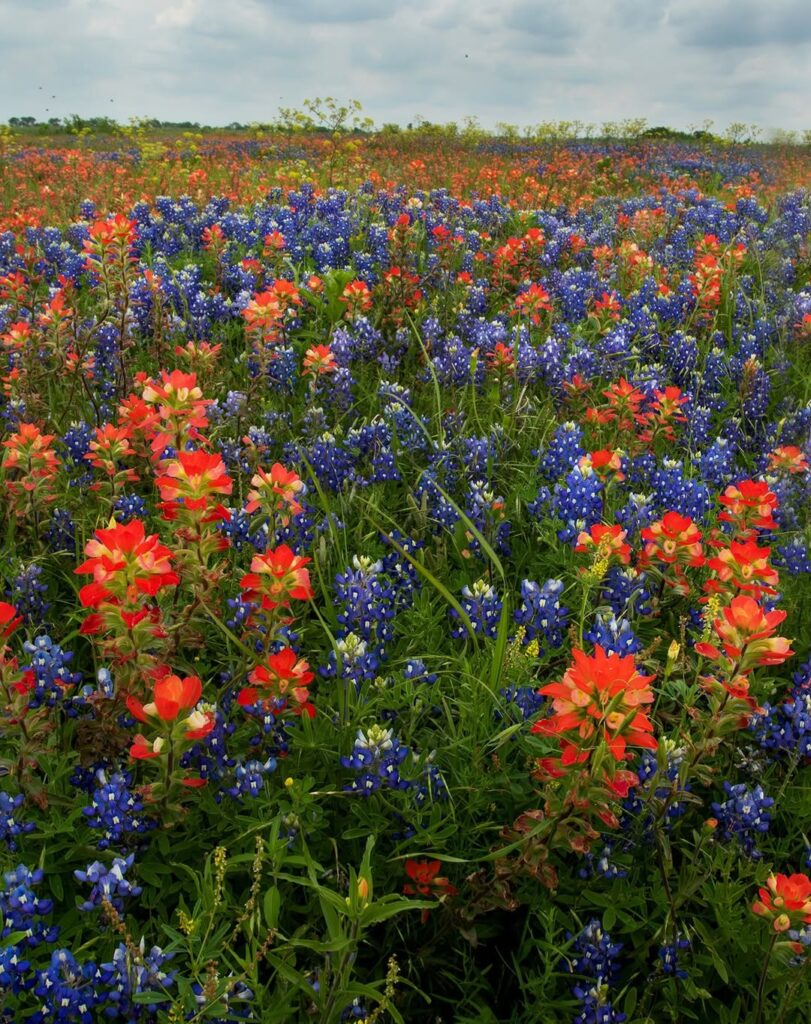
Indian Paintbrush stands as one of Texas’s most beloved wildflowers, creating stunning spring displays with its vibrant red-orange spikes across prairies and grasslands. This unique annual herb grows up to 18 inches tall, producing distinctive paintbrush-like clusters that are actually colorful modified leaves called bracts, while the true flowers remain small and greenish.
As a hemiparasitic plant, Indian Paintbrush forms fascinating relationships with nearby grasses, tapping into their root systems for enhanced nutrition while remaining capable of independent survival. This adaptation, combined with its drought tolerance and ability to thrive in various soil types, makes it an excellent choice for native Texas landscapes and wildflower gardens. The species also serves as an important larval host for the Buckeye butterfly, supporting local pollinator populations.
- Hardiness: Annual herb, adapted to central and southern United States climate zones
- Light: Full sun exposure required for ideal growth and blooming
- Water: Drought tolerant once established, requires minimal supplemental watering
- Soil: Adaptable to well-drained sandy, loamy, and clay soils
- Fertilizer: Low nutrient requirements due to hemiparasitic nature obtaining nutrients from host plants
- Pest/Disease Resistance: Generally resistant with few major pest or disease issues
- Growth Rate: Moderate spring growth, blooming season begins in March in Texas
Bluebonnet Texas State Flower
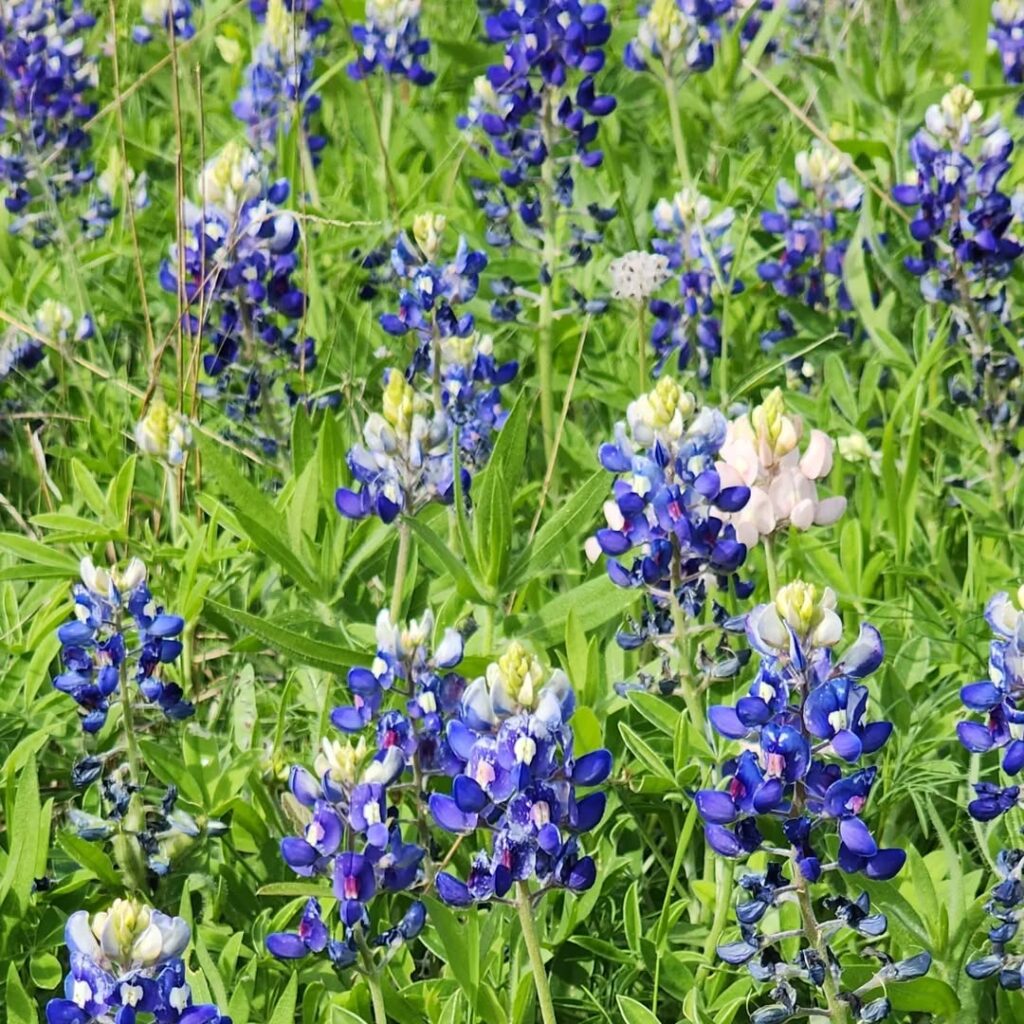
The Texas bluebonnet (Lupinus texensis) stands as the official state flower, designated in 1901 for its embodiment of Texas pride and resilience. This native wildflower creates stunning blue carpets across the landscape from mid-March through April, featuring distinctive palmately compound leaves and vibrant blue flowers with characteristic white tips.
Renowned for its exceptional drought tolerance and adaptability to challenging Texas conditions, the bluebonnet thrives in rocky, well-drained soils while contributing to ecological health through nitrogen fixation. As a true wildflower champion, it easily self-seeds and establishes sustainable populations, supporting pollinators and serving as a cornerstone of roadside beautification programs throughout the state. Each flower cluster can contain up to 50 individual fragrant blooms that attract various beneficial insects.
- Hardiness: USDA zones 8-10, extremely heat and drought tolerant
- Light: Full sun required for ideal growth and flowering
- Water: Low water requirements once established, drought resistant
- Soil: Well-drained, rocky or sandy soils preferred, pH 6.0-8.0
- Fertilizer: None required, fixes nitrogen naturally through root nodules
- Pest/Disease Resistance: Excellent resistance to most pests and diseases
- Growth Rate: Annual with moderate growth, 12-24 inches tall at maturity
Black-Eyed Susan Wildflower
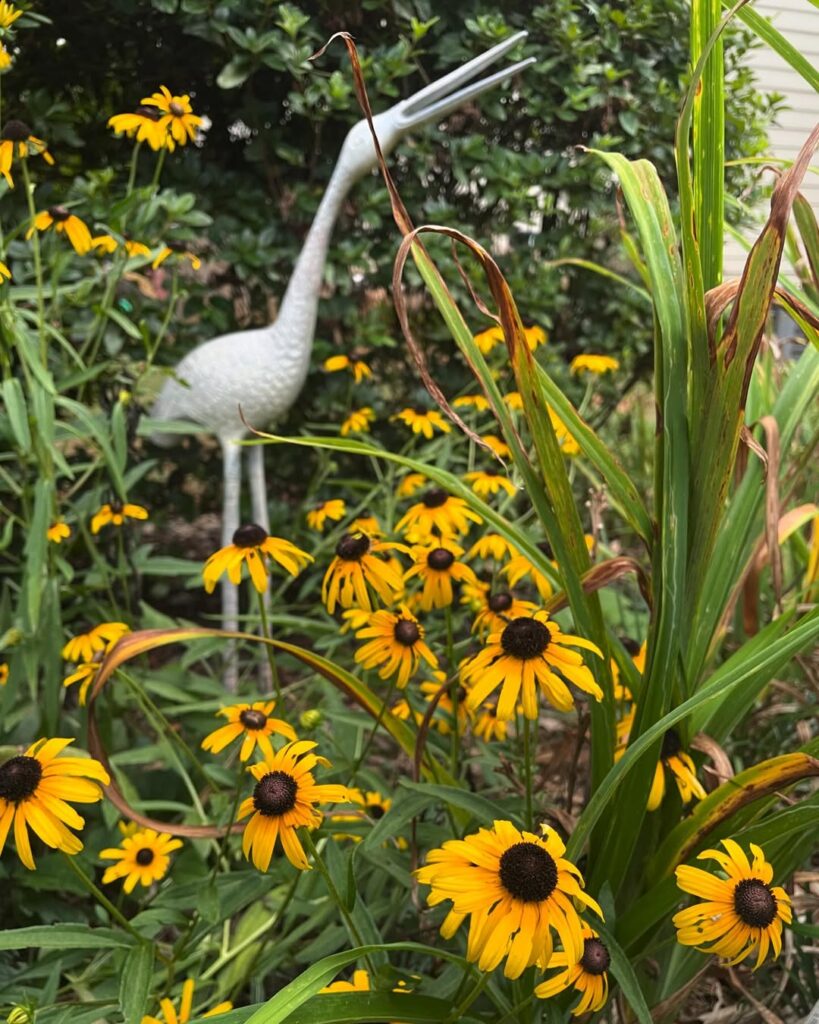
Black-Eyed Susan stands as one of Texas’s most beloved native wildflowers, earning its champion status through exceptional drought tolerance and stunning visual appeal. This golden-yellow daisy produces vibrant blooms with distinctive dark brown centers from June through October, creating magnificent displays across prairies and meadows.
As a true Texas native, Black-Eyed Susan thrives in the state’s challenging climate while providing vital support to local wildlife. Bees and butterflies depend on its nectar, while birds feast on the nutritious seeds. Its ability to naturalize and self-seed makes it an excellent choice for low-maintenance wildflower gardens and prairie restorations. The bright-yellow flowers typically measure 2-3 inches wide and feature coarse, rough stems that support the daisy-like flower heads.
- Hardiness: Annual, biennial, or short-lived perennial; adapts to various Texas climate zones
- Light: Full sun preferred; tolerates some afternoon shade
- Water: Medium water needs with high drought tolerance once established
- Soil: Well-drained soils; prefers acidic pH below 6.8; adapts to various soil types
- Fertilizer: Minimal fertilizer needs; thrives in average to poor soils
- Pest/Disease Resistance: Deer resistant; generally pest and disease free
- Growth Rate: Moderate growth rate; reaches up to 3 feet tall; may self-seed aggressively in ideal conditions
Firewheel Blanket Flower
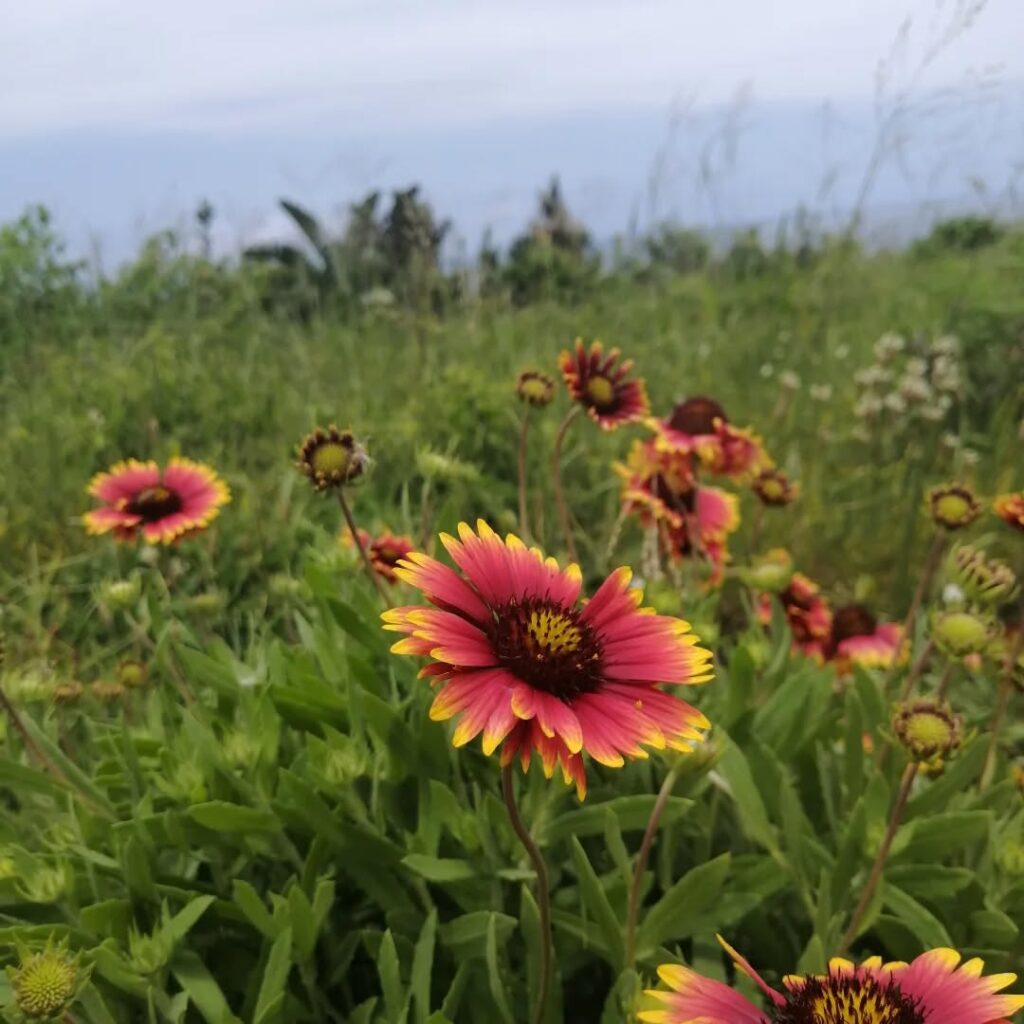
Gaillardia pulchella, commonly known as Firewheel or Indian Blanket, is a vibrant native Texas wildflower that produces stunning pinwheel-like blooms in brilliant reds and yellows. This member of the Aster family typically grows 1-2 feet tall with gray-green foliage and demonstrates exceptional heat tolerance and drought resistance.
The Firewheel’s extended blooming period from February to December makes it invaluable for supporting pollinators and wildlife throughout most of the year. Its ability to self-seed and thrive in challenging conditions where other plants struggle makes it an ideal low-maintenance choice for Texas landscapes, wildflower meadows, and xeriscapes. The genus was named after Antoine Gaillard, an 18th-century French magistrate who contributed to botanical knowledge.
- Hardiness: Annual, thrives in central and southern United States climates with high heat tolerance
- Light: Full sun preferred, tolerates light shade
- Water: Low water requirements, highly drought resistant once established
- Soil: Well-drained sandy or calcareous soils, adaptable to wide pH range from slightly acidic to alkaline
- Fertilizer: Minimal to no fertilizer needed, thrives in poor soils
- Pest/Disease Resistance: Excellent resistance, very few pest or disease issues
- Growth Rate: Moderate to fast, readily self-seeds for natural propagation
Pink Evening Primrose
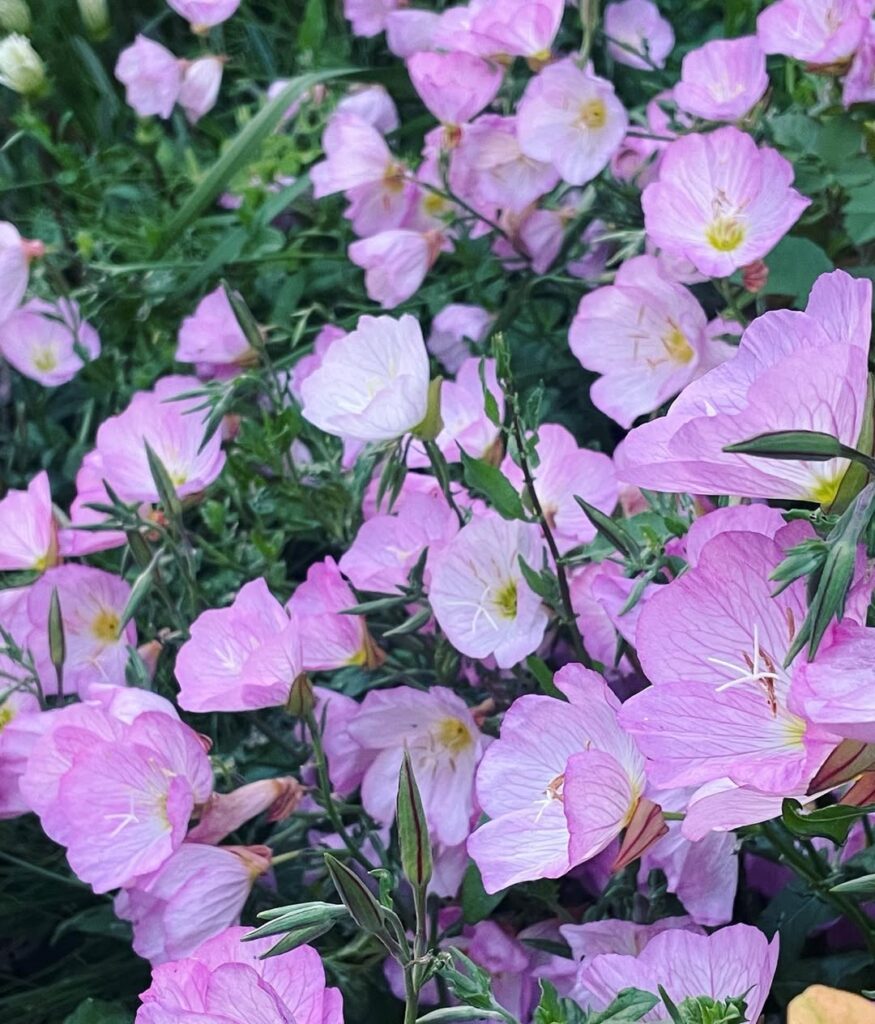
Pink Evening Primrose stands as one of Texas’s most resilient wildflower champions, native to the central grasslands and now naturalized throughout the state. This perennial herb produces delicate cup-shaped flowers in shell pink to white with distinctive rose overtones and bright yellow centers. Blooming from February through July, it forms spectacular colonies along roadsides, in prairies, and open spaces, spreading aggressively through underground rhizomes to create dense, eye-catching displays that support pollinators and native wildlife. The four-petaled flowers open in the evening or morning hours, with each bloom lasting only a single day before fading.
- Hardiness: USDA zones 4-9, extremely drought tolerant and cold hardy
- Light: Full sun preferred, tolerates partial shade
- Water: Low to moderate water needs, survives extended drought periods
- Soil: Adaptable to sand, loam, clay, and caliche; well-draining preferred
- Fertilizer: None required, thrives in poor soils
- Pest/Disease Resistance: Excellent resistance, very few pest or disease issues
- Growth Rate: Fast spreading through rhizomes, aggressive colonizer
Heat-Tolerant Native Texas Trees
Texas native trees offer exceptional heat tolerance and drought resistance, including sturdy oaks, compact drought-resistant varieties, beautiful flowering species, adaptable maples, and reliable evergreens. These resilient trees can live 300 years while providing excellent shade and withstanding the harshest conditions.
Live Oak Tree
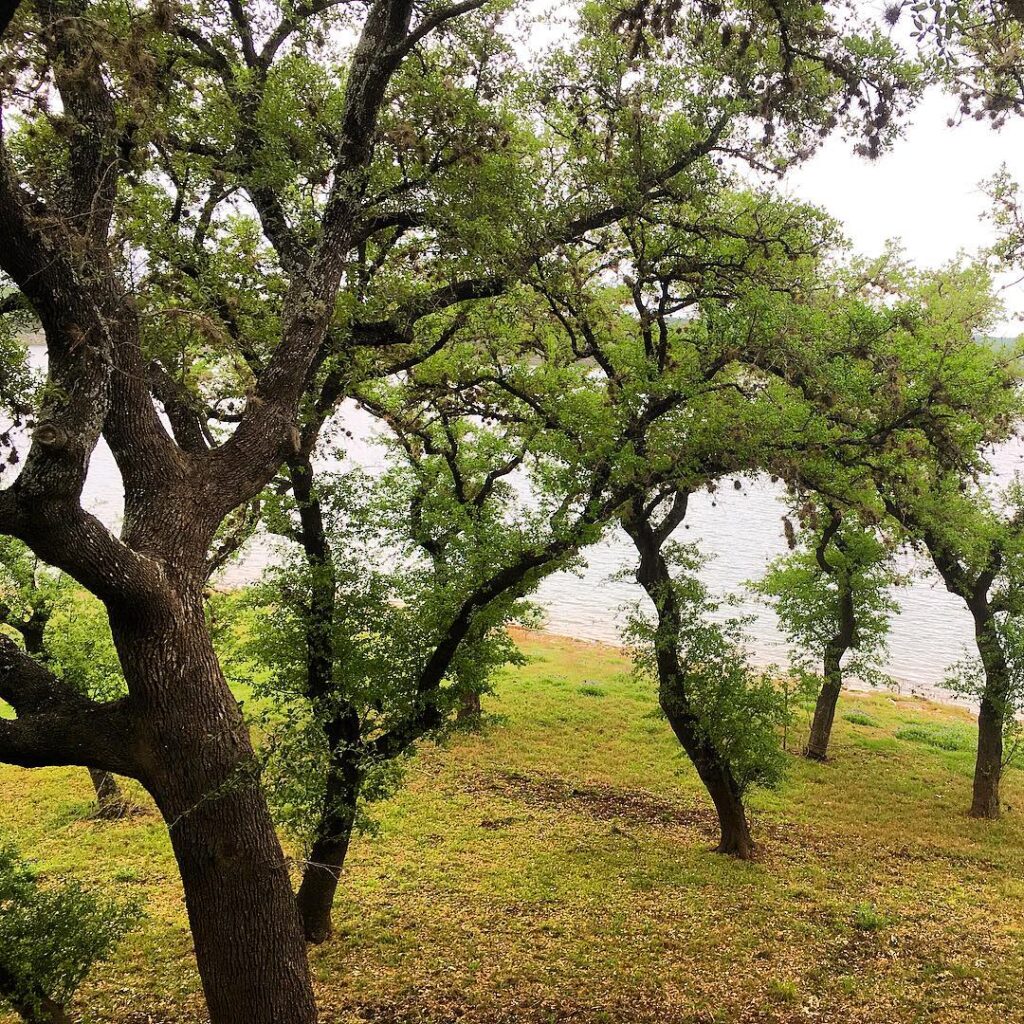
Live oak trees are among Texas’s most resilient and iconic native species, with escarpment live oak (Quercus fusiformis) and southern live oak (Quercus virginiana) being the most common varieties. These evergreen trees are perfectly adapted to the state’s challenging climate, displaying exceptional drought tolerance and thriving in hot summers with intense sun exposure. Their broad, arching canopies provide valuable shade while requiring minimal water once established.
Beyond their practical benefits as shade trees, live oaks play significant ecological roles in Texas landscapes. They produce acorns that feed wildlife, provide nesting habitat for birds, and serve as host plants for native butterflies. Their dense, strong wood and extensive root systems make them excellent for erosion control on hills and uplands, while their year-round foliage and attractive branching structure make them popular choices for sustainable landscaping and xeriscaping projects. These trees can achieve impressive dimensions with a growth rate of up to 12 inches per year, though they typically take about twenty years to develop into substantial shade providers.
- Hardiness: USDA zones 8-10, cold-hardy to -20°F
- Light: Full sun to partial shade
- Water: Low water requirements; drought tolerant once established
- Soil: Adaptable to rocky, sandy, clay, caliche, limestone, and slightly acidic soils
- Fertilizer: Minimal fertilizer needs; thrives in native soils
- Pest/Disease Resistance: Generally resistant to most pests and diseases
- Growth Rate: Slow to moderate; reaches 40-50 feet tall with equal or greater spread
Texas Red Oak Tree

The Texas Red Oak is a magnificent native shade tree that exemplifies drought tolerance and adaptability in the challenging Texas climate. Naturally occurring on limestone ridges and rocky slopes from Central Texas to the Edwards Plateau, this robust oak can reach up to 80 feet tall with a broad, rounded canopy. Its deep root system and natural heat resistance make it an exceptional choice for sustainable landscaping.
This stately tree offers year-round appeal with glossy dark green foliage that transforms to striking red and brown tones in fall. The Texas Red Oak produces small acorns that provide valuable food for local wildlife while requiring minimal maintenance once established. The distinctive leaves feature bristle-tipped lobes that are widest above the middle, creating an attractive textural element in the landscape. Its ability to thrive in intense heat and limited water conditions makes it an ideal native alternative for creating substantial shade in residential and commercial landscapes throughout Texas and adjacent regions.
- Hardiness: USDA Zones 6-11, tolerates temperature extremes and drought conditions
- Light: Full sun, performs well on south or west-facing exposures with intense heat
- Water: Low water needs once established, drought resistant with minimal supplemental irrigation
- Soil: Well-drained soils, tolerates dry, sandy, rocky, and slightly acidic conditions
- Fertilizer: Low maintenance, adapted to native soil conditions with minimal fertilizer requirements
- Pest/Disease Resistance: Good resistance to common issues, demonstrates urban stress tolerance
- Growth Rate: Fast growing, can exceed 24 inches annually under favorable conditions
Cedar Elm Tree

The Cedar Elm is Texas’s most widespread native elm, forming an impressive oval-rounded canopy that reaches 50-70 feet tall and 40-60 feet wide. Distinguished by its small, sandpapery leaves and scaly bark with corky ridges, this adaptable tree thrives in the challenging limestone “cedar breaks” alongside Ashe Juniper.
Exceptionally drought-tolerant once established, Cedar Elm excels in difficult growing conditions that challenge other trees. It provides excellent shade during hot summers while allowing winter sunlight penetration, and offers attractive yellow-orange fall color. The tree serves as an important wildlife food source and requires minimal maintenance. Cedar Elm also serves as a larval host for beautiful butterflies including Mourning Cloak and Question Mark species.
- Hardiness: Very hardy, tolerates extreme heat, drought, and challenging soil conditions
- Light: Full sun to partial shade
- Water: Low to moderate; excellent drought tolerance once established
- Soil: Highly adaptable to heavy clay, compacted, rocky, alkaline, and poorly drained soils
- Fertilizer: Minimal requirements; thrives without regular fertilization
- Pest/Disease Resistance: Good resistance; requires minimal care
- Growth Rate: Moderately fast in favorable conditions
Texas Redbud Tree
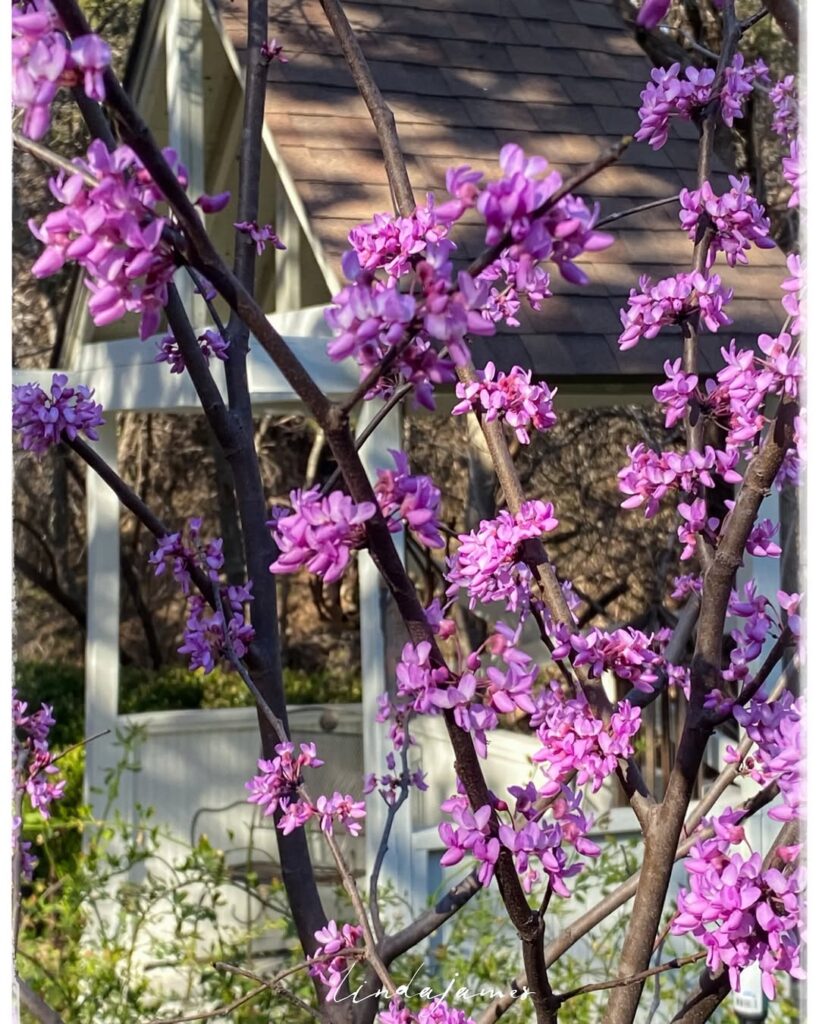
The Texas Redbud is a native, multi-trunk tree that reaches 15-20 feet tall and wide. Distinguished by its thick, glossy leaves that are smaller and rounder than other redbud varieties, this drought-tolerant species thrives in the challenging conditions of central Texas, southern Oklahoma, and northeastern Mexico. Its gray to reddish-brown bark features distinctive white spots and dense lenticels.
This heat-adapted native produces stunning red-pink flowers in spring before leaf emergence, making it an excellent understory or accent tree. The Texas Redbud is the most drought-resistant of all redbud varieties, requiring minimal maintenance once established. Its flowers attract beneficial pollinators while providing larval habitat for Henry’s Elfin butterfly, and the edible blooms can be used in culinary applications. The heart-shaped leaves provide excellent summer shade and transform to yellow in fall, adding seasonal interest to the landscape.
- Hardiness: USDA zones 6-9, native to southern Oklahoma, central Texas, and northeastern Mexico
- Light: Full sun to part shade, benefits from late afternoon shade protection
- Water: Low to medium water needs, minimal watering required once established
- Soil: Well-drained, calcareous soils including rocky, sandy, loamy, or clay; tolerates thin, poor, limestone-based soils
- Fertilizer: Minimal fertilizer needs, benefits from compost incorporation at planting
- Pest/Disease Resistance: Moderate deer resistance, generally low pest and disease issues
- Growth Rate: Slow growth rate
Mesquite Tree

The mesquite tree is a quintessential Texas native with distinctive grey-green fern-like leaves and characteristically curved branches. This multi-trunked deciduous tree features shaggy bark and can reach up to 30 feet tall, though under ideal conditions some specimens can grow 40 to 50 feet tall with spreads exceeding 40 feet. Known for being one of the last trees to leaf out in May, mesquites have historically served as natural indicators for Texas farmers who would wait for their emergence before planting crops.
Mesquites produce yellow flowers from April to May, followed by edible pods that were extensively used by Southwestern Indigenous peoples. The tree’s name derives from the Aztec word “mizquitl” and has been part of the Texas landscape since before Spanish exploration in the early 1500s.
- Hardiness: USDA zones corresponding to 5°F minimum temperature
- Light: Full sun
- Water: Low water requirements once established; highly drought-tolerant but needs deep watering initially to develop tree form
- Soil: Well-drained sandy, loam, clay, or caliche soils
- Fertilizer: Minimal requirements as a legume family member
- Pest/Disease Resistance: Excellent resistance due to native adaptation
- Growth Rate: Fast growth rate
Drought-Tolerant Native Texas Shrubs
Texas native shrubs offer exceptional drought tolerance while providing year-round structure, seasonal color, and wildlife habitat. These versatile plants thrive in challenging conditions with minimal water requirements. Cloud Sage produces vibrant purple blooms and requires minimal maintenance, making it an excellent choice for water-wise landscaping.
Agarito Thorny Berry Shrub

The Agarito (Mahonia trifoliolata) is an evergreen shrub native to Southwestern United States and Northern Mexico, growing 3-6 feet tall with rigid, spreading branches that form thickets. This extremely drought-tolerant plant features distinctive gray-green to blue-gray trifoliate foliage with needle-sharp tips and produces fragrant yellow flowers in early spring.
Following the blooming period, Agarito produces edible red berries from May to July that are prized for their excellent flavor and jelly-making qualities. The plant’s thorny nature makes it ideal for areas requiring deer-resistant landscaping, though it should be planted away from pedestrian pathways. Beyond wildlife deterrence, Agarito provides valuable food and shelter for beneficial pollinators including bees and butterflies, as well as birds that feed on its berries.
- Hardiness: Cold hardy to 0°F (-18°C), USDA zones 7-10
- Light: Full sun to part shade
- Water: Extremely drought tolerant, minimal water requirements once established
- Soil: Well-drained loam, clay, caliche, and limestone soils
- Fertilizer: No fertilization required, adapted to poor soils
- Pest/Disease Resistance: Very deer resistant, generally pest and disease free
- Growth Rate: Moderate, reaches 3-6 feet at maturity
Cenizo Purple Sage Shrub
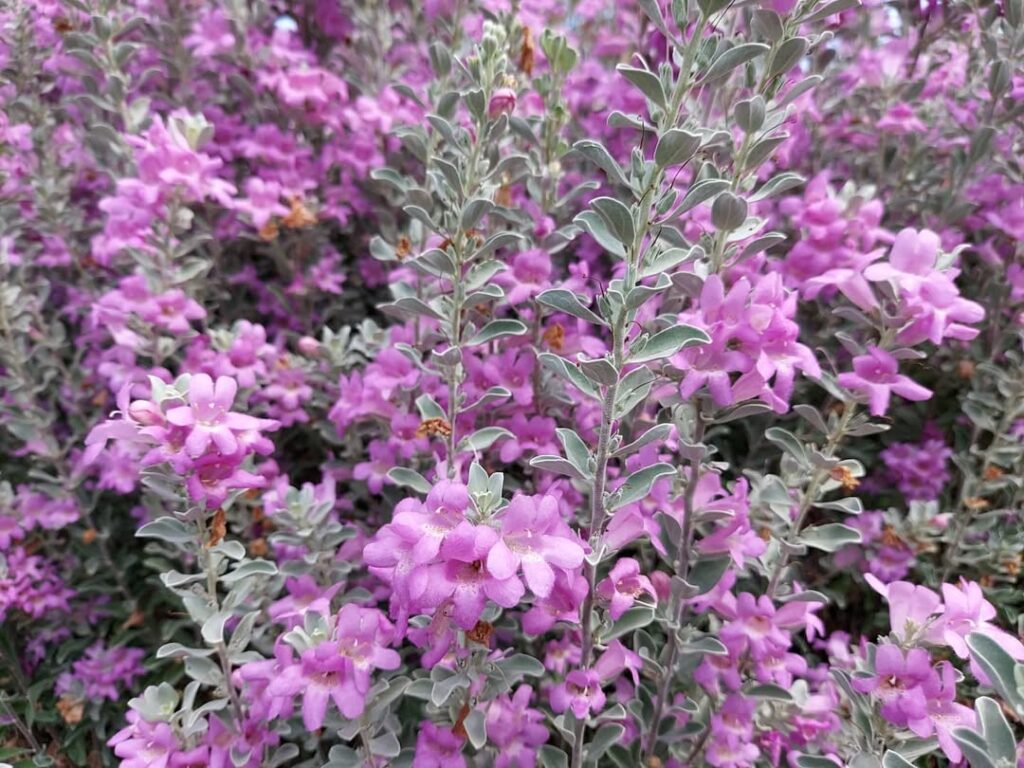
Beyond its low-maintenance appeal, Cenizo offers significant ecological benefits by attracting pollinators while remaining deer-resistant. Its adaptability to poor soils, extreme temperatures, and minimal water requirements makes it ideal for sustainable Texas landscapes, whether used as informal hedging, foundation plantings, or wildlife habitat enhancement. This remarkable shrub earns its nickname as a barometer bush because its blooming is triggered by summer rainfall patterns.
- Hardiness: Zones 8-10, tolerates heat and cold extremes typical of Texas
- Light: Full sun required; becomes weak and leggy in shade
- Water: Extremely drought-tolerant once established; minimal supplemental irrigation needed
- Soil: Adaptable to various soil types including rocky, poor, and infertile ground
- Fertilizer: No fertilizer required; thrives in low-nutrient conditions
- Pest/Disease Resistance: Excellent resistance to pests and diseases; deer-resistant
- Growth Rate: Moderate; maintains compact form naturally without pruning
Fragrant Sumac Desert Shrub
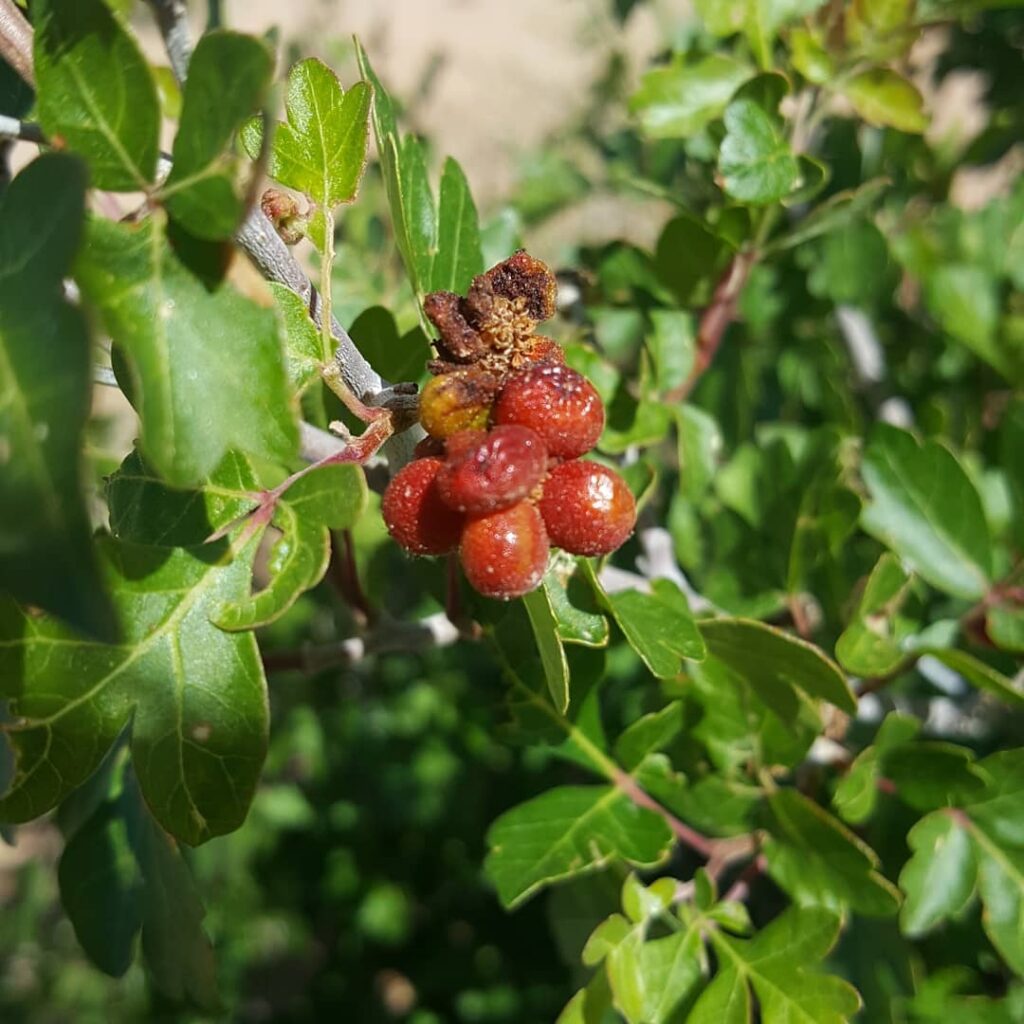
Fragrant Sumac (Rhus aromatica) is a low-growing, spreading deciduous shrub native to Texas that typically reaches 2-4 feet tall and up to 10 feet wide. This hardy native features glossy, trifoliate blue-green leaves that emit a pleasant lemony fragrance when crushed and transform into brilliant orange, red, purple, and yellow hues in fall.
The shrub produces small yellowish catkin-like flowers in early spring before foliage emerges, followed by clusters of dark red, hairy berries that persist through winter. Fragrant Sumac spreads by root suckers to form dense thickets, making it excellent for erosion control and slope stabilization while providing valuable wildlife habitat and food sources. The berries serve as important winter food for small animals and birds.
- Hardiness: USDA zones 3-8, tolerates temperatures down to -40°F
- Light: Full sun to partial shade
- Water: Drought-tolerant once established, requires minimal supplemental watering
- Soil: Tolerates wide range including poor, sandy, clay, or rocky soils
- Fertilizer: No fertilizer needed
- Pest/Disease Resistance: Highly resistant to most common pests and diseases
- Growth Rate: Moderate, spreads by root suckers to form colonies
Yaupon Holly Evergreen Shrub
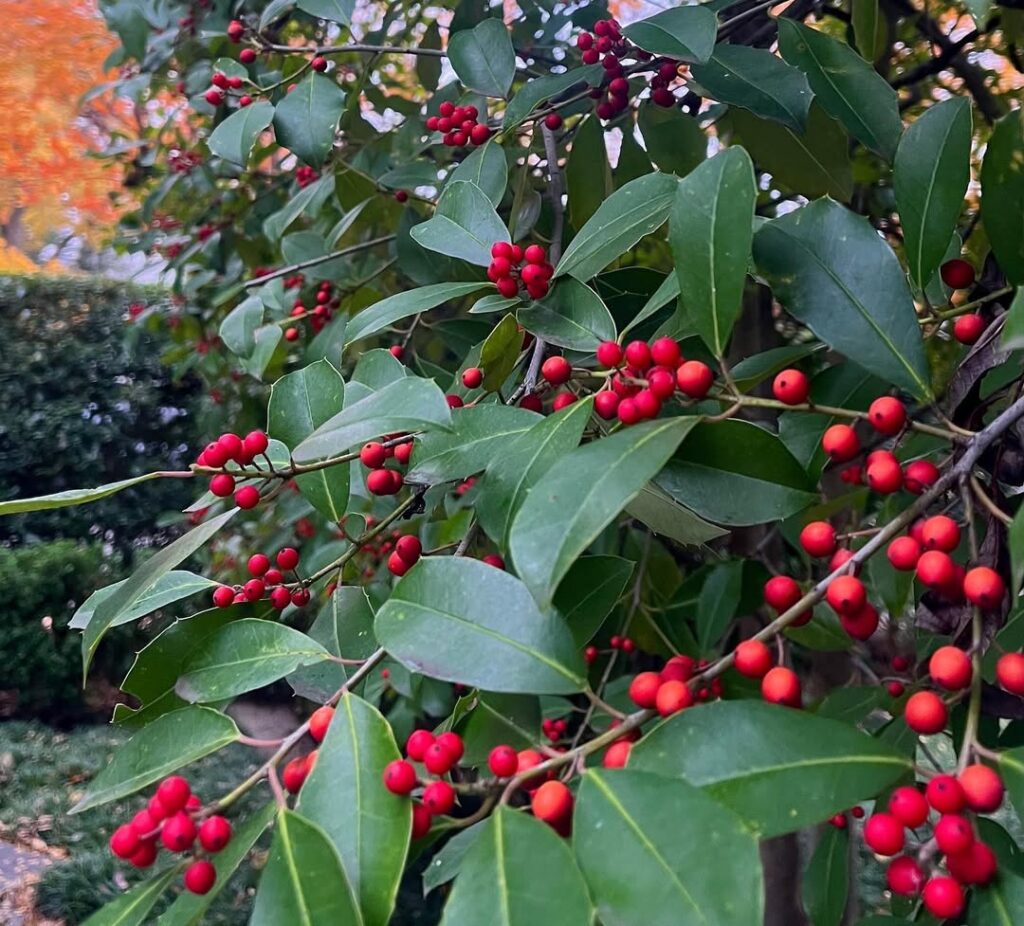
Yaupon Holly is a versatile native Texas evergreen shrub that typically grows 12-25 feet tall with multiple stems and distinctive light gray bark marked with white patches. This adaptable plant produces small white spring flowers followed by bright red berries on female plants that persist through winter, creating year-round ornamental interest.
Originally found in the eastern quarter of Texas, Yaupon Holly has significant cultural importance as Native Americans historically used its caffeine-containing leaves to prepare ceremonial teas. The plant’s dense growth habit makes it excellent for hedges, wind barriers, or as a small ornamental tree when properly pruned. The dense branches also provide excellent wildlife shelter and nesting sites for birds and other wildlife.
- Hardiness: Zones 7-10, native to eastern Texas
- Light: Full sun to full shade
- Water: Drought-tolerant once established, performs better with moderate moisture
- Soil: Tolerates nearly any soil type including sandy, clay, and coastal soils
- Fertilizer: Low maintenance, minimal fertilizer requirements
- Pest/Disease Resistance: Excellent resistance to most pests and diseases
- Growth Rate: Slow to moderate growth rate
Turk’s Cap Red Shrub

Turk’s Cap is a native Texas shrub that produces distinctive bright red, tube-shaped flowers from summer through fall. These unique hibiscus-like blooms never fully open, creating their characteristic “turban” appearance while attracting hummingbirds and butterflies. Growing 2-5 feet tall with equal spread, this evergreen shrub thrives in diverse habitats from rocky slopes to wooded stream banks.
This drought-tolerant native is ideal for xeriscaping and low-maintenance landscapes. Once established, Turk’s Cap maintains vigor during extended dry periods and recovers well from environmental stress. The shrub features heart-shaped, downy green leaves that provide dense cover, making it both ornamental and functional in garden settings. In full sun conditions, gardeners should monitor for mildew issues that may cause leaf crinkling and affect plant health.
- Hardiness: USDA zones 7-10, native to Gulf Coast regions
- Light: Shade to partial sun, adaptable to diverse lighting conditions
- Water: Low to moderate; highly drought-tolerant once established
- Soil: Adaptable; thrives in rocky slopes and various soil types with good drainage
- Fertilizer: Minimal requirements; adapted to native soil conditions
- Pest/Disease Resistance: Generally resistant with good recovery from environmental stress
- Growth Rate: Rapid growth with coarse, upright form
Selecting the Right Native Plants for Your Garden
How do you choose native plants that’ll actually survive Texas’s brutal droughts while still creating a beautiful garden? Start by considering regional climate adaptations – Central Texas differs dramatically from Southwest Texas. Your plant combination strategies should group species with similar water needs together.
Look for silvery foliage, which indicates natural drought mechanisms. Deep root systems tap groundwater during surface droughts. Texas Lantana and Red Yucca offer reliable performance with minimal maintenance.
Evaluate mature size before planting. Combine flowering plants like Black-eyed Susan with structural shrubs such as Texas Sage for year-round interest and continuous color through strategic blooming seasons. Native plants form symbiotic relationships with local wildlife that have developed over thousands of years.
Frequently Asked Questions
How Often Should I Water Newly Planted Native Texas Plants?
You should follow a specific watering schedule for plant establishment: water daily for two weeks, then every other day for another two weeks. Match water amounts to your plant’s original pot size.
What Native Texas Plants Attract Butterflies and Hummingbirds?
Like nature’s candy store, you’ll attract both butterflies and hummingbirds with Texas Lantana, Flame Acanthus, and Turk’s Cap. These natives outperform traditional butterfly gardens and hummingbird feeders while thriving in Texas heat.
Can Drought-Resistant Native Plants Survive Texas Freeze Events?
You’ll find that drought-resistant native plants demonstrate excellent freeze survival through natural plant resilience. Species like Cenizo and Crossvine maintain their evergreen foliage while surviving Texas cold snaps alongside drought conditions.
Where Can I Purchase Native Texas Plant Seeds Locally?
You’ll find native Texas plant seeds at local native plant nurseries like Redenta’s Garden in Dallas or Marshall Grain Company in Grapevine. Contact local gardening clubs for additional supplier recommendations.
Do Native Texas Plants Require Special Fertilizers or Soil Amendments?
Most native Texas plants evolved in nutrient-poor soils for thousands of years. You don’t need special fertilizers since native plant adaptations handle local soil pH requirements naturally, thriving without amendments.
